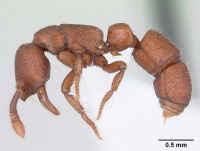Boloponera vicans
| Boloponera vicans | |
|---|---|

| |
| Scientific classification | |
| Kingdom: | Animalia |
| Phylum: | Arthropoda |
| Class: | Insecta |
| Order: | Hymenoptera |
| Family: | Formicidae |
| Subfamily: | Ponerinae |
| Tribe: | Ponerini |
| Genus: | Boloponera |
| Species: | B. vicans |
| Binomial name | |
| Boloponera vicans Fisher, 2006 | |
This species is currently known from a single specimen from a rainforest leaf-litter (miniWinkler) sample in the Central African Republic near the border of Gabon, Cameroon, and Congo. The collection details (from leaf litter) in combination with morphological characteristics (e.g., lack of eyes) suggests that it is cryptobiotic. The identity of its prey is unknown but its linear mandibles are suggestive of prey specialization.
Identification
Hawkes (2018) - Boloponera ikemkha is readily distinguished from its only known congener by the highly polished torular lobes and lack of standing hairs on the scapes, mesosoma, petiole and first gastral tergite. These distinctions, as well as others, are noted in the following couplet:
- Torular lobes distinctly longitudinally striate; first gastral tergite with standing hairs and appressed pubescence; subpetiolar process with a strongly developed posteriorly projecting acute tooth; mesosoma dorsum, scapes and femora longitudinally striate between scattered piligerous foveolae (Central African Republic) . . . . . Boloponera vicans
- Torular lobes smooth and highly polished without striations; first gastral tergite with appressed pubescence only; subpetiolar process terminating in a blunt slightly recurved posteroventral point, but without a strong posteriorly projecting acute tooth; mesosoma dorsum, scapes and femora smooth and shining between scattered piligerous foveolae (South Africa). . . . . Boloponera ikemkha
See Boloponera for features that separate B. vicans workers from similar Ponerinae genera.
Keys including this Species
Distribution
Latitudinal Distribution Pattern
Latitudinal Range: 3.033333333° to 3.033333333°.
| North Temperate |
North Subtropical |
Tropical | South Subtropical |
South Temperate |
- Source: AntMaps
Distribution based on Regional Taxon Lists
Afrotropical Region: Central African Republic (type locality).
Distribution based on AntMaps
Distribution based on AntWeb specimens
Check data from AntWeb
Countries Occupied
| Number of countries occupied by this species based on AntWiki Regional Taxon Lists. In general, fewer countries occupied indicates a narrower range, while more countries indicates a more widespread species. |

|
Estimated Abundance
| Relative abundance based on number of AntMaps records per species (this species within the purple bar). Fewer records (to the left) indicates a less abundant/encountered species while more records (to the right) indicates more abundant/encountered species. |

|
Biology
Castes
Only known from the worker caste.
Images from AntWeb
 
| |
| Holotype of Boloponera vicans. Worker. Specimen code casent0401737. Photographer April Nobile, uploaded by California Academy of Sciences. | Owned by CAS, San Francisco, CA, USA. |
Nomenclature
The following information is derived from Barry Bolton's Online Catalogue of the Ants of the World.
- vicans. Boloponera vicans Fisher, 2006: 113, figs. 1-4, 24 (w.) CENTRAL AFRICAN REPUBLIC.
- Type-material: holotype worker.
- Type-locality: Central African Republic: Prefecture Sangha-Mbaéré, Parc National Dzanga-Ndoki, Mabéa Bai, 21.4 km. 53° NE Bayanga (03°02’00’’N, 016°24’36’’E), 510 m., 1-7.v.2001, BLF04000, rainforest, sifted litter (B.L. Fisher).
- Type-depository: CASC.
- Status as species: Hawkes, 2018: 27 (in key).
- Distribution: Central African Republic.
Unless otherwise noted the text for the remainder of this section is reported from the publication that includes the original description.
Description
Worker
Measurements (holotype). TL 3.3, HL 0.79, HW 0.67, CI 85, SL 0.41, SI 62, ML 0.98.
Inner margin of mandible blade with two small, blunt teeth located in basal half of inner margin. Eyes absent. Posterior margin of head slightly concave. Antenna with two-segmented club. Propodeal declivity bordered on each side by raised lamella that does not extend across dorsum. Femoral grove not visible on mesofemur; metafemur with a longitudinal groove present along entire length. Petiole quadrate in profile; subpetiolar process with posterior projecting acute tooth. Abdomen strongly constricted between A3 and A4.
Head, posterior of frontal lobes, densely foveolate punctate; punctures less than one diameter apart and overlaid and separated by reticulate or longitudinal rugae; dorsum of mesosoma with a few shallow punctures, mostly striate. Sides of mesosoma with inconspicuous striae. Propodeal declivity with a few transverse striae but otherwise smooth and highly polished. Petiole with effaced punctures and striae. A3 and A4 with foveolate punctures larger and sparser than on cephalic dorsum; longitudinal rugae present on central dorsum of A3.
Punctures on dorsum of head and mesosoma each with a small suberect hair arising from center, the hair approximately twice the diameter of the puncture. Longer standing hairs present on metanotum, petiole, A3 and A4.
Type Material
Holotype worker. Central African Republic: Prefecture Sangha-Mbaéré, Parc National Dzanga-Ndoki, Mabéa Bai, 21.4 km 53° NE Bayanga; (03° 02' 00" N, 016° 24' 36" E) 510 m, 1.-7.V.2001, leg. B.L. Fisher, rainforest, sifted litter, B.L. Fisher collection code: BLF04000, specimen code: CASENT0401737, 1 worker (California Academy of Sciences).
References
- Esteves, F.A., Fisher, B.L. 2021. Corrieopone nouragues gen. nov., sp. nov., a new Ponerinae from French Guiana (Hymenoptera, Formicidae). ZooKeys 1074, 83–173 (doi:10.3897/zookeys.1074.75551).
- Fisher, B. L. 2006. Boloponera vicans gen.n. and sp.n. and two new species of the Plectroctena genus group Hymenoptera: Formicidae). Myrmecol. Nachr. 8:111-118.
References based on Global Ant Biodiversity Informatics
- Fisher B. L. 2006. Boloponera vicans gen.n. and sp.n. and two new species of the Plectroctena genus group (Hymenoptera: Formicidae). Myrmecologische Nachrichten 8: 111-118.

